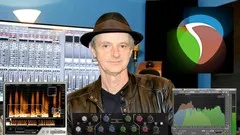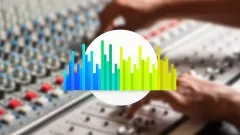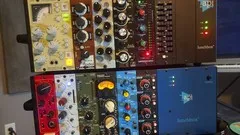
Audio Production Level 2 - EQ (Equalizer) 
Elevate your audio production skills with this comprehensive EQ course. Designed to demystify EQ theory, it's filled with practical examples and comparisons, providing all necessary audio and plugin resources. Unlike courses with predetermined EQ settings, this program imparts knowledge to craft your settings for any audio scenario. Learn about frequencies, spectrum analyzers, harmonic series, shelf EQs, frequency sweeping, microphone placement, frequency masking, spectral editing, and enhancing EQing by ears. Polish your EQ skills, master audio balancing, and shape your mixes like a pro. Perfect for musicians, producers, sound engineers, and beginners. Start your journey towards expert audio production today! Get a comprehesive understanding of Audio Production Level 2 - EQ (Equalizer) which is a pay course. AZ Class provides this course data for free. Learn more certificate and details here. ▼
ADVERTISEMENT
Course Feature
![]() Cost:
Cost:
Paid
![]() Provider:
Provider:
Udemy
![]() Certificate:
Certificate:
Paid Certification
![]() Language:
Language:
English
![]() Start Date:
Start Date:
2022-02-23
Course Overview
❗The content presented here is sourced directly from Udemy platform. For comprehensive course details, including enrollment information, simply click on the 'Go to class' link on our website.
Updated in [October 16th, 2023]
What does this course tell?
(Please note that the following overview content is from the original platform)
Audio Production Level 2 - EQ (Equalizer)This course makes EQ theory understandable and gives many practical examples and comparisons to help you improve your audio production I provide all the audio and plugins needed Instead of just giving pre-determined settings for EQs for different instruments&voices this course provides the knowledge so that you can work out your own settings for absolutely any given situation As with Audio Production Level 2 - Compressors it gives a solid grounding moving forward in the competent use of EQIntroductionA comprehensive breakdown of everything you will learn in every section of this courseA recommendation to do the course in the order its presented to get the most out of it and whyHow to contact the tutor if you have any questionsSection 2: FrequenciesSpectrum Analyzers Using one plugin and two audio filesWhat is a Spectrum Analyzer what it does and how it can be usefulA description of the pluginA step by step guide to setting up the pluginSaving settings as a pre-setUseful features of the pluginSolving a problem using the Spectrum Analyser and the Reaper EQHarmonic Series Part 1The plugin and audio file that are usedThe different ways and terms of measuring the capability of human hearingThe direct relationship between frequencies and musical notesWhat the harmonic series isAn explanation of the Harmonic Series ChartHarmonic Series Part 2Hearing the different harmonics within an audio noteWhat effect it has when the different harmonics are turned downHaving a first look at a spectrogramUsing the EQ to remove individual harmonics and hearing the difference it makesFrequency RangesExplanation of whats on the screenDividing the sound into 3 frequency rangesListening to how cutting the different frequency ranges soundsUsing the EQ to boost the high frequencySection 3: EQing Effectivel7High Pass FiltersHigh Pass Filters on vocalsThe plugins being used in this lessonWhy you use a high pass filter when its hard to hear any differenceLooking and listening to below the turnover frequencyWhat we are listening toThe two main reasons to use a High Pass FilterShelf EQsHigh shelf and Low shelf EqsWhat they are really effective forAlternative ways to achieve a similar effectListening to and fine tuning the EQExamples using High and Low shelf EQsFrequency Sweeping Part 1Why we use frequency sweepingThe three different frequency sweeping techniquesHow each of them workUsing solo and sweep with Reapers EQ and then with SPANFrequency Sweeping Part 2Frequency sweeping for problem solving to be turned downEnhancing "sweet spots" by turning them upBell EQA closer look at the Bell EQ and extending its usefulnessUsing two Eqs to change the shape of a Bell EQ and hearing the effectHow the ColourEQ worksAll its functions and its pros and consEQing by Microphone PlacementLooking at what an EQ isHow to alter the tone of the audio with careful microphone placementListening to how the different mic placements affect the recordingCombining different microphonesSection 4: Frequency JugglingLecture 13 Frequency MaskingUsing two audio files and two plug-insLooking at how the new plug-in worksUnderstanding why we use frequency jugglingExamples of when frequency juggling isnt wantedVisuals of different instruments playing the same notePanning option pros and consPitch shift optionBoosts and FiltersFrequency juggling within the context of a small mixWhere to use EQ boosts and whyUsing frequency sweeping to find the nice and less nice sounding frequenciesListening to before and after using EQUsing Filters to affect the backing vocals and make them blend with the rest of the trackKick and BassExplanation of basic filtering of the tracks used in this lectureListening to tracks with and without kick and bassLooking at the spectrum analyser to see the frequency ranges in the kick and bassUsing boosting and cutting to help both kick and bass to be clearly heardSection 5: Spectral EditingSpectral Editing IntroThe audio and plugin used in this lectureWhat Spectral Editing meansLooking at the various ways of visualising audioInformation about SpectroOpening the pluginAn example of the plugin in actionSpectral Editing - FixingExample of fixing in action in a drum loopExample of fixing in action in a guitar loopAn overview of Spectro and the buttons not already coveredDemonstrations of the fixesSpectral Editing - EnhancingThe audio used in this sessionWhere we want to enhanceBefore and after using the enhancementSection 6: EQ-ing With Your EarsIntroThe huge importance of training your ears rather than completely relying on visual aidsAn introduction to this sectionAn in-depth explanation of the SSQ plug-in (with minimal visual aids) used in this sectionExercise 1 Single TrackStarting by EQ-ing a single trackWatching volume levels and whyDeciding on beefing up the kik and making it tighterEnhancing the ride cymbalA full explanation of what I am doing with the SSQ plug-inListening to the "before" and "after"Exercise 2 MixingMixing a section of the multi-track session just using EQ and to show what a big part EQ plays when mixingUsing and naming the 6 tracks being usedThe plugin which will be usedReferring to many techniques used in previous lecturesA point to remember when MixingGetting a general mix before EQ-ingListening to the drum overheads and using EQ to adjust and balanceListening to the bass and making both the bass and the drums work well together and hear each clearlyMaking sure the guitar and bass can be heard clearlyBringing in the snareListening and EQ-ing the rhythm guitarListening and EQ-ing the lead guitarUsing EQ to sit well together
We considered the value of this course from many aspects, and finally summarized it for you from two aspects: skills and knowledge, and the people who benefit from it:
(Please note that our content is optimized through artificial intelligence tools and carefully reviewed by our editorial staff.)
What skills and knowledge will you acquire during this course?
Understanding EQ Theory: Gain a comprehensive understanding of equalization theory, including the science of sound, frequency ranges, and the principles behind EQ.
Practical Application: Learn how to use EQ effectively in audio production, from basic to advanced techniques. Understand the concepts of curves, filters, and various EQ modes.
Frequency Analysis: Explore the use of spectrum analyzers and how to interpret and utilize them to enhance audio quality. Learn about the relationships between frequencies and musical notes.
Harmonic Series: Understand the harmonic series, its significance, and how it impacts audio quality.
Spectrum Management: Learn to divide sound into different frequency ranges, manipulate them using EQ, and enhance high frequencies for improved audio clarity.
Specific Techniques: Explore high-pass filters, shelf EQs, and how to apply these to vocals and instruments effectively.
Frequency Sweeping: Understand the purpose of frequency sweeping, techniques for identifying and solving audio issues, and how to fine-tune audio using EQ.
Microphone Placement: Learn how to alter audio tone through microphone placement and how different mic placements affect recordings.
Frequency Masking: Explore frequency masking, pitch shifting, and other techniques for resolving audio conflicts within a mix.
Spectral Editing: Gain expertise in spectral editing to fix and enhance audio using specialized tools.
EQ-ing by Ear: Emphasize the importance of ear training and the use of visual aids for optimal audio equalization.
Practical Exercises: Apply learned skills through hands-on exercises, such as single-track EQ-ing and mixing sessions.
Who will benefit from this course?
Music Producers: Music producers seeking to enhance their audio production skills, particularly in the domain of equalization, will find this course valuable.
Sound Engineers: Aspiring sound engineers and audio enthusiasts can gain essential knowledge and practical experience in using equalizers effectively.
Musicians: Musicians who want to improve the quality of their recordings and take control of their sound in the studio or live settings.
Audio Technicians: Individuals pursuing a career as audio technicians, whether in live sound, recording, or post-production, can build a strong foundation in equalization techniques.
Recording Studio Personnel: Those working in recording studios, including engineers and technicians, can enhance their skills in shaping audio with EQ.
Audio Enthusiasts: Individuals passionate about audio who aim to understand and apply equalization techniques to enhance the quality of music and audio projects.
Course Syllabus
Introduction
Frequencies
EQing Effectively
Frequency Juggling
Spectral Editing
EQing With Your Ears
Course Provider

Provider Udemy's Stats at AZClass
Discussion and Reviews
0.0 (Based on 0 reviews)
Explore Similar Online Courses

Linux Essentials Skill Test

Learn how to create viral content and reach more Audience

Python for Informatics: Exploring Information

Social Network Analysis

Introduction to Systematic Review and Meta-Analysis

The Analytics Edge

DCO042 - Python For Informatics

Causal Diagrams: Draw Your Assumptions Before Your Conclusions

Whole genome sequencing of bacterial genomes - tools and applications

Audio Equalization (EQ) Techniques and Tips

EQ Essentials: Ultimate Guide to Using Equalization in Music


Start your review of Audio Production Level 2 - EQ (Equalizer)